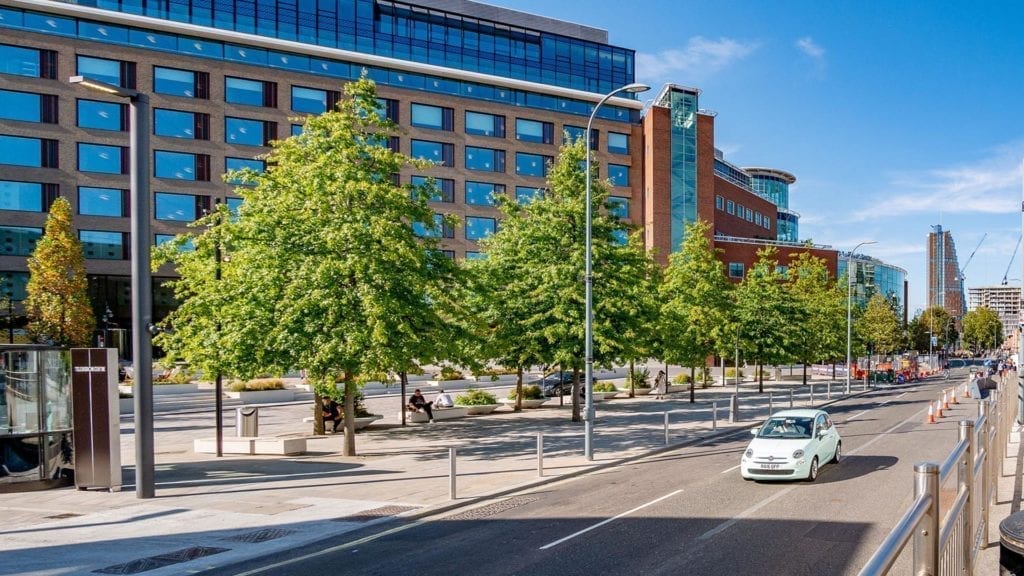GreenBlue were delighted to see a DEFRA announcement dated 12th March for a government-led funding scheme: The Local Authority Treescapes Fund – designed to increase new tree planting and natural regeneration in locations outside woodlands, helping our great nation-build back greener following the pandemic.
A total of £2.7 million has been released from the central Government with applications accepted from April 2021; up to 50 grants (each between £50,000 to £300,000) are available for local authorities to plant new trees, encourage natural redevelopment of trees, to restore neglected green spaces, encourage biodiversity, tackle stormwater and reduce air pollution in their communities. Funding is available via top tier authority applications to all local authorities – to discover more on how to apply click here.

On top of this the Mayor of London has also launched a funding programme Future Neighbourhoods 2030 – tackling some of London’s environmental challenges, funding to be located in the most disadvantaged and “Climate vulnerable areas” or those most affected by the pandemic.
The recent announcement supports the Prime Minister’s commitment to plant or naturally regenerate 30,000 hectares per year by 2025, as part of the £80 million 10 Point Plan to kick-start our green recovery.
With trees at the heart of the UK’s ambitious environmental programme, we ask; “Are there enough green planners?” and “Do they have sufficient tools available to enable such targets?” – particularly in our public urban realms where the challenges to retro-fit implementation can be daunting?
 Our previous blog highlighted the need for a clear green infrastructure (GI) strategy and supporting local policies, along with the need for community engagement and collaboration with stakeholders. With many towns set to double in size over the next 20 years, there is already pressure on existing GI being lost to development. However, we hope that this opens up new opportunities to create large areas of high-quality GI within these new developments.
Our previous blog highlighted the need for a clear green infrastructure (GI) strategy and supporting local policies, along with the need for community engagement and collaboration with stakeholders. With many towns set to double in size over the next 20 years, there is already pressure on existing GI being lost to development. However, we hope that this opens up new opportunities to create large areas of high-quality GI within these new developments.
For us, at GreenBlue this is, of course, our key focus – for planners to insist on long term green and blue infrastructure to ensure such opportunities do not become value-engineered, to choose quality over quantity, and protect developments against long-term liability and maintenance issues from the start.
What Tools are available?
There are a variety of tools to aid planners and specifiers – if there are any that we have missed feel free to email us at [email protected]
ArborSystem Configurator – Design your own Tree Pit
CAD Drawings – Standard Drawings FREE to download
Resource Centre – Wealth of literature
Case Studies – Range of global tree planting scenarios
iTree-Eco – To enable the measurement of ecosystem services
CAVAT – Capital Asset Value for Amenity Trees
GIVT Green Infrastructure Valuation Tool Kit
CNT – Guide to Valuing Green Infrastructure by Centre Neighbourhood Technology (NA)
The B£ST SuDS Tool
BNG Calculator – The Biodiversity Metric
Improved planning collaboration can maximise the benefits delivered; valuation of the benefits delivered can help to make the business case clear for investment; leading to more green infrastructure improvements being delivered. A high-quality network of well-designed GI can transform an area into a more attractive place to live, work and invest – as well as improving the health, well-being and quality of life of everyone in the area.
A recent High Court ruling showed that a robust local policy or Supplementary Planning Document (SPD) is necessary if Biodiversity Net Gain (BNG) is to be effective, as the legal case for insisting on the implementation is weak without it.
Our latest upcoming panel webinar will discuss whose responsibility is it if the green elements of the design are unbuildable because of utility challenges or other onsite constraints, which have historically been used as an excuse for excluding these vital features for long term health and wellbeing. Each of the visiting speakers will be discussing real-life examples and the tools available that can assist with transforming grey areas to green and blue living ones – many have been highly successful against great odds.
 Our panellists include Eva Kurland (UDL), Ian Hingley (Urban Movement), Simon Needle (Birmingham City Council) and Vicky Payne (URBED) – all champions of the industry, each highlighting effective tools, planning aids, successful collaborative tactics, and showcasing award-winning projects. Discover more and register today.
Our panellists include Eva Kurland (UDL), Ian Hingley (Urban Movement), Simon Needle (Birmingham City Council) and Vicky Payne (URBED) – all champions of the industry, each highlighting effective tools, planning aids, successful collaborative tactics, and showcasing award-winning projects. Discover more and register today.


